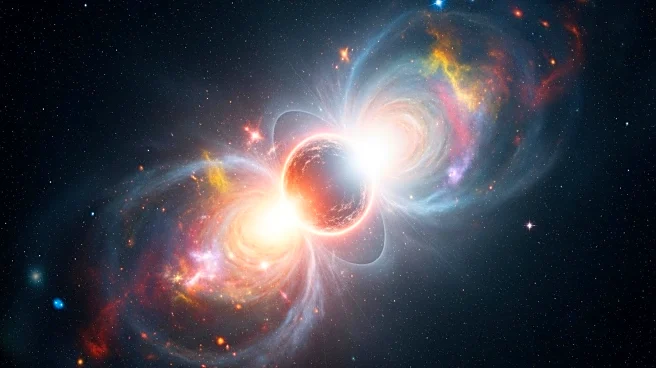What is the story about?
What's Happening?
Recent simulations conducted by researchers from Penn State and the University of Tennessee Knoxville have revealed that the mixing and transformation of neutrinos during neutron star mergers significantly impact the merger's unfolding and the resulting emissions. Neutron stars, the dense remnants of collapsed stars, collide in these energetic events, producing signals observable from Earth. The study, published in Physical Review Letters, is the first to simulate neutrino 'flavor' transformations in such mergers. Neutrinos, fundamental particles that interact weakly with matter, can change flavors under specific conditions, affecting the types of particles they interact with. The research team built a comprehensive simulation incorporating various physical processes, including gravity and general relativity, to study these transformations. They found that neutrino mixing influences the composition and structure of the merger remnant and the types and quantities of elements, such as heavy metals and rare earth elements, produced during the merger.
Why It's Important?
The findings have significant implications for understanding the origins of metals and rare earth elements, which are crucial for various technologies, including smartphones and electric vehicle batteries. The study suggests that accounting for neutrino mixing could increase the production of these elements by up to ten times. Additionally, the research highlights the potential impact of neutrino mixing on the emissions detectable from Earth, such as gravitational waves and electromagnetic radiation. This understanding is vital for interpreting future observations with advanced detectors like LIGO, Virgo, and the proposed Cosmic Explorer observatory. By providing insights into extreme physics that cannot be replicated on Earth, neutron star mergers serve as cosmic laboratories, enhancing our knowledge of the universe's fundamental processes.
What's Next?
The research team anticipates that other groups will utilize the developed simulation infrastructure to further explore the impacts of neutrino mixing in neutron star mergers. As theoretical particle physics advances, these simulations can be improved, offering more precise insights into where and how neutrino transformations occur. The ongoing development of next-generation detectors will likely lead to more frequent detections of gravitational waves, necessitating a deeper understanding of the emissions from neutron star mergers to accurately interpret these observations.
AI Generated Content
Do you find this article useful?














